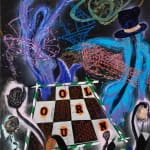

Dewey Crumpler
Retuals 001, 2024
acrylic, oil sticks, glitter and mixed media on canvas
72 x 60 in (182.9 x 152.4 cm)
Copyright The Artist
Regarding this new series, Crumpler has explained he is interested in the transformative potential of arts, and how the representation of consciousness itself opens the door for viewers to experience...
Regarding this new series, Crumpler has explained he is interested in the transformative potential of arts, and how the representation of consciousness itself opens the door for viewers to experience new modes of thinking. The series unites numerous symbols known to his larger practice, while also introducing new references to Haitian and West African religious practices including veve symbols and the associated names of deities or spirits in these practices. This piece invokes the name Olorun, the supreme creator deity of the Yoruba people of West Africa, and features in some diasporic religions, particularly of the Caribbean. Hashed out across the grid with Olorun’s name, a variety of veves from vodun/vodou describe a pantheon of lwa, or spirits: Erzulie Dantor (lwa who is protective mother of Haiti), Damballah-Wedo (lwa who is sky father), Papa Legba (lwa of speech and understanding), Ayizan (lwa of the market and commerce), and Ogoun (lwa of masculinity, iron, craftsmanship, war). Flying high above them, alongside the hoodie and container ships, ship-like veve represent Agwe, the lwa of the ocean, fish, ships, and patron to fishermen. Alongside these classical symbols, Crumpler crafts his own iconography, interweaving his long-running narratives such as that of the hoodie, the modern container ship, the tulip, and the slave collar. Bringing together old and new, Crumpler’s work compares contemporary mythologies to historic practices and also proposes a continuity from past to the present.
Dewey Crumpler (b. 1949, Magnolia, Arkansas) is an artist, painter, and muralist renowned for his vibrant works. Blending various materials and digital imagery, his works transcend traditional boundaries, creating surreal experiences that merge video, mixed media, sculpture, and traditional painting techniques. In examining themes of race, capitalism, and the history of oppression, Crumpler has long been preoccupied with the ways in which objects can be sites of exploration for what it means to be Black, bringing light to the aesthetic freedom that leads to Black liberation.
Crumpler was an Associate Professor of Painting of the San Francisco Art Institute, where he taught Kehinde Wiley and Deborah Roberts. His practice began as a city muralist, studying under the late Pablo Esteban O’Higgins and David Alfaro Siqueiros. On view til December 10, 2024, Crumpler has a solo exhibition titled Dewey Crumpler: Life Studies at the David C. Driskell Center, and he has an upcoming solo exhibition at the Museum of African Diaspora in 2026. His work is included in permanent collections of the Oakland Museum of California; the Triton Museum of Art, CA; and the California African American Museum. Digital images of his murals were included in the 2017 Tate Modern’s Soul of a Nation. He received a National Endowment for the Arts Fellowship Grant, a Flintridge Foundation Award, and the Fleishhacker Foundation Fellowship Eureka Award. Crumpler currently lives and works in Berkeley and San Francisco, CA.
Dewey Crumpler (b. 1949, Magnolia, Arkansas) is an artist, painter, and muralist renowned for his vibrant works. Blending various materials and digital imagery, his works transcend traditional boundaries, creating surreal experiences that merge video, mixed media, sculpture, and traditional painting techniques. In examining themes of race, capitalism, and the history of oppression, Crumpler has long been preoccupied with the ways in which objects can be sites of exploration for what it means to be Black, bringing light to the aesthetic freedom that leads to Black liberation.
Crumpler was an Associate Professor of Painting of the San Francisco Art Institute, where he taught Kehinde Wiley and Deborah Roberts. His practice began as a city muralist, studying under the late Pablo Esteban O’Higgins and David Alfaro Siqueiros. On view til December 10, 2024, Crumpler has a solo exhibition titled Dewey Crumpler: Life Studies at the David C. Driskell Center, and he has an upcoming solo exhibition at the Museum of African Diaspora in 2026. His work is included in permanent collections of the Oakland Museum of California; the Triton Museum of Art, CA; and the California African American Museum. Digital images of his murals were included in the 2017 Tate Modern’s Soul of a Nation. He received a National Endowment for the Arts Fellowship Grant, a Flintridge Foundation Award, and the Fleishhacker Foundation Fellowship Eureka Award. Crumpler currently lives and works in Berkeley and San Francisco, CA.


